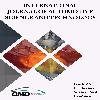An experimental examination of the effect of temperature distributions in different welding sorting of the part transmitting thrust in front loader of tractors by means of MAG method on displacements
Distortion analysis; Gas metal arc welding; Heat transfer; Temperature distribution; Vehicle design., Distortion analysis; Gas metal arc welding; Heat transfer; Temperature distribution; Vehicle design., Distortion analysis; Gas metal arc welding; Heat transfer; Temperature distribution; Vehicle design., Distortion analysis; Gas metal arc welding; Heat transfer; Temperature distribution; Vehicle design.
An experimental examination of the effect of temperature distributions in different welding sorting of the part transmitting thrust in front loader of tractors by means of MAG method on displacements
Distortion analysis Gas metal arc welding, Temperature distribution, Distortion analysis; Gas metal arc welding; Heat transfer; Temperature distribution; Vehicle design., Vehicle design.,
___
- Kunt MA. An experimental investigation of exhaust waste heat recycling by thermoelectric generators under different thermal conditions for internal combustion engines. Proceedings of the Institution of Mechanical Engineers, Part D: Journal of Auto-mobile Engineering 2017; 232: 1648-1653.
- Nart E, Celik Y. A practical approach for simulating submerged arc welding process using FE method. Journal of constructional steel research 2013; 84: 62-71.
- Yavuz N, Özcan R and Polat FG. Tozaltı kaynak bağlantısının sonlu elemanlar yöntemi ile termal ve mekanik analizi. Uludağ University Mühendislik-Mimarlık Fakültesi Dergisi 2005; 2: 9-19.
- Kaya F. Ark kaynak yöntemiyle birleştirilen çelik malzemelerin nümerik olarak modellenmesi. Master’s Theses, Sakarya Uni-versity, Türkiye, 2010.
- Wu A, Syngellakis S, & Mellor BG. Finite element analysis of residual stresses in a butt weld. In: The Post Graduate Confer-ence in Engineering Materials Proceedings, University of Southampton. 2001.
- Wen SW, Hilton P, & Farrugia DCJ. Finite element modelling of a submerged arc welding process. Journal of Materials Pro-cessing Technology 2001; 119: 203-209.
- Gunaraj V, & Murugan N. Prediction of heat-affected zone characteristics in submerged arc welding of structural steel pipes. Welding Journal 2002; 81: 94-98.
- Song J, Peters J, Noor A, & Michaleris P. Sensitivity analysis of the thermomechanical response of welded joints. International Journal of Solids and Structures. 2003; 40: 4167-4180.
- Joshi S, Hildebrand J, Aloraier AS & Rabczuk T. Characteriza-tion of material properties and heat source parameters in weld-ing simulation of two overlapping beads on a substrate plate. Computational Materials Science 2013; 69: 559-565.
- Piekarska W, Kubiak M. Modeling of thermal phenome-na in single laser beam and laser-arc hybrid welding processes using projection method. Applied Mathematical Modelling 2013; 37: 2051-2062.
- Nezamdost MR, Esfahani MN, Hashemi SH & Mir-bozorgi SA. Investigation of temperature and residual stresses field of submerged arc welding by finite element method and experiments. The International Journal of Advanced Manufac-turing Technology 2016; 87: 615-624.
- Fachinotti VD, Cardona A, Baufeld B & Van der Biest O. Finite-element modelling of heat transfer in shaped metal depo-sition and experimental validation. Acta materialia 2012; 60: 6621-6630.
- Pu X, Zhang C, Li S, & Deng D. Simulating welding residual stress and deformation in a multi-pass butt-welded joint considering balance between computing time and predic-tion accuracy. The International Journal of Advanced Manu-facturing Technology 2017; 93: 2215-2226.
- Knoedel P, Gkatzogiannis S & Ummenhofer T. Practical aspects of welding residual stress simulation. Journal of Con-structional Steel Research 2017; 132: 83-96.
- Yadav A, Ghosh A & Kumar A. Experimental and nu-merical study of thermal field and weld bead characteristics in submerged arc welded plate. Journal of Materials Processing Technology 2017; 248: 262-274.
- Podder D, Mandal NR & Das S. Heat source modeling and analysis of submerged arc welding. Welding journal 2014; 93: 183-191.
- Minh PS, Phu TV. Study on the structure deformation in the process of gas metal arc welding (GMAW). American Journal of Mechanical Engineering 2014; 2: 120-124.
- Zhang J, Yu L, Liu Y, et al. Analysis of the effect of tungsten inert gas welding sequences on residual stress and dis-tortion of CFETR vacuum vessel using finite element simula-tions. Metals 2018; 11:1-18.
- Çengel YA and Ghajar AJ. Heat Transfer A Practical Approach. İstanbul: Palme Yayıncılık, 2017, p.27.
- Eryürek İB. Çelikler İçin Örtülü Elektrot Seçimi. İstanbul: Kaynak Tekniği Sanayi ve Ticaret A.Ş., 2007, p.11.
- Kuka smart automation systems, https://www.kuka.com/en-us/products/robotics-systems/industrial-robots/kr-cybertech-arc (2022, accessed 10 jun 2022).
- Fronius welding machine, https://www.fronius.com/en-us/usa/welding-technology/products/manual-welding/migmag/tpsi/tpsi/tps-320i (2022, accessed 10 jun 2022).
- Yayın Aralığı: 4
- Başlangıç: 2016
- Yayıncı: Otomotiv Mühendisleri Derneği
Brazing of Different Metal Alloys with Highly-Silver Flux Addition and Microstructure Investigation
Mechanical Evaluation of Road Durability Test in Battery Electric Buses
Efe SAVRAN, Burcu YILDIRIM, Umut ÇANDIR, Fatih KARPAT
Case Study of Intralogistics in The Framework of Logistics 4.0
Mustafa AKIN, Mehmet Can DURMUŞ, İmren MEYDAN, Emel ATILAL
Emrah ERÇEK, Şükrü Ayhan BAYDIR
Performance Analysis of Geometric Properties of Fuel Cell Components
Beyza Nur YAVUZ, Hüseyin KAHRAMAN
A Gear Form-Grinding Optimization Method Based on Neural Network
Modeling of Electric Vehicles as a Load Of The Distribution Grid
